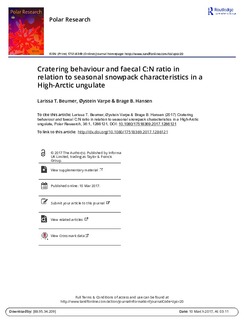| dc.contributor.author | Beumer, Larissa Teresa | |
| dc.contributor.author | Varpe, Øystein | |
| dc.contributor.author | Hansen, Brage Bremset | |
| dc.date.accessioned | 2017-10-25T12:02:56Z | |
| dc.date.available | 2017-10-25T12:02:56Z | |
| dc.date.created | 2016-09-28T10:42:31Z | |
| dc.date.issued | 2017 | |
| dc.identifier.citation | Polar Research. 2017, 36 (1), . | nb_NO |
| dc.identifier.issn | 0800-0395 | |
| dc.identifier.uri | http://hdl.handle.net/11250/2462096 | |
| dc.description.abstract | Snow and ice determine winter forage availability for Arctic herbivores. Winter precipitation is anticipated to increase, and icing following warm spells and rain-on-snow (ROS) are likely to become more frequent. While this may reduce herbivore survival, fecundity and population growth, we can also expect behavioural and dietary responses. Here, we tested predictions from optimal foraging theory on how changing snowpack conditions influence choice of feeding craters and diet quality in a large generalist herbivore, the wild Svalbard reindeer. Snow and ice conditions over winter 2012/13 (a ‘normal’ winter with little ROS and icing) were measured in reindeer feeding craters, in paired controls one metre away and in fixed control sites. On average, feeding craters had less snow and integrated ram hardness (IRH, the force needed to reach the ground), but not less ice, than nearby controls. However, on this fine spatial scale, reindeer tended to select for microhabitat with worse snowpack conditions up to a certain level of snow (ca. 10 cm), ice (0.5 cm) and IRH (250 kg cm) in the nearby controls, reflecting the trade-off between selection for forage abundance versus accessibility in a sparsely vegetated environment. In this lichen-free system, faecal C:N ratios increased during winter as forage accessibility was increasingly restricted by snow, possibly indicating a reduction in diet quality due to changes in diet composition. Our study suggests that snowpack depth and hardness largely determine Svalbard reindeer feeding behaviour and diet quality during the course of a winter season. | nb_NO |
| dc.language.iso | eng | nb_NO |
| dc.publisher | Taylor & Francis | nb_NO |
| dc.rights | Navngivelse-Ikkekommersiell 4.0 Internasjonal | * |
| dc.rights.uri | http://creativecommons.org/licenses/by-nc/4.0/deed.no | * |
| dc.title | Cratering behaviour and faecal C:N ratio in relation to seasonal snow-pack characteristics in a High-Arctic ungulate | nb_NO |
| dc.type | Journal article | nb_NO |
| dc.type | Peer reviewed | nb_NO |
| dc.description.version | publishedVersion | nb_NO |
| dc.source.pagenumber | 12 | nb_NO |
| dc.source.volume | 36 | nb_NO |
| dc.source.journal | Polar Research | nb_NO |
| dc.source.issue | 1 | nb_NO |
| dc.identifier.doi | 10.1080/17518369.2017.1286121 | |
| dc.identifier.cristin | 1386758 | |
| dc.relation.project | Norges forskningsråd: 224647 | nb_NO |
| dc.relation.project | Svalbards miljøvernfond: 13/74 | nb_NO |
| dc.relation.project | Norges forskningsråd: 223257 | nb_NO |
| dc.description.localcode | © 2017 The Author(s). Published by Informa UK Limited, trading as Taylor & Francis Group. This is an Open Access article distributed under the terms of the Creative Commons Attribution-NonCommercial License (http://creativecommons.org/licenses/by-nc/4.0/),which permits unrestricted non-commercial use, distribution, and reproduction in any medium, provided the original work is properly cited. | nb_NO |
| cristin.unitcode | 194,66,10,0 | |
| cristin.unitname | Institutt for biologi | |
| cristin.ispublished | true | |
| cristin.fulltext | original | |
| cristin.qualitycode | 1 | |

